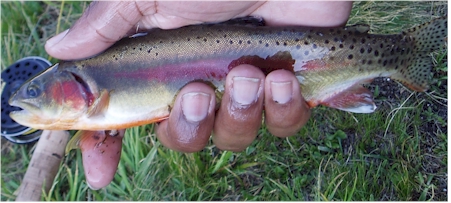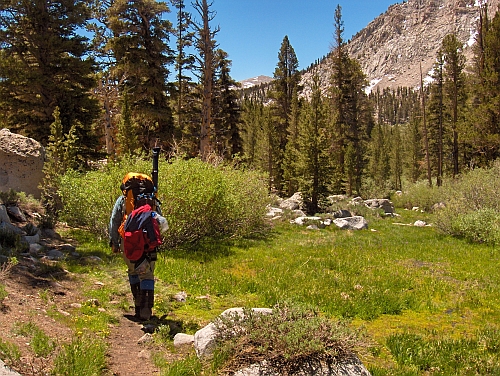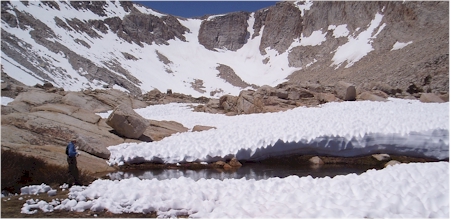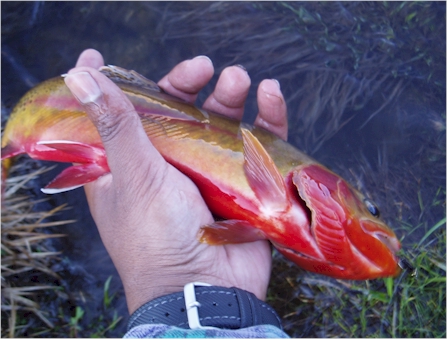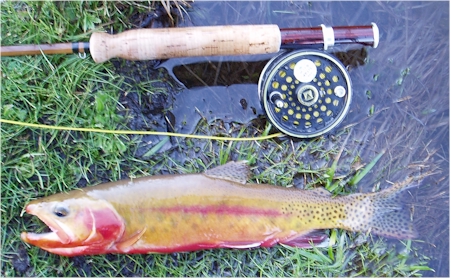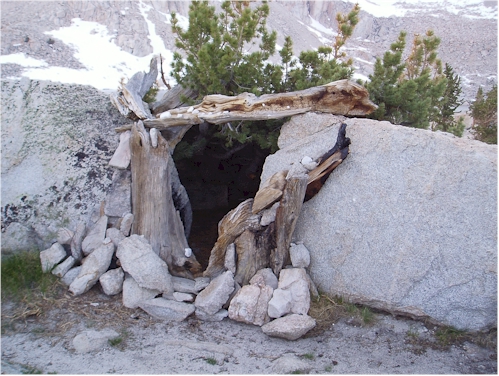|
|
|
|
|
July 2- 3 2005 Cottonwood Lakes
Weather: Sunny and Mild, below freezing at night. Narrative: This trip had the makings of an interesting one. The signs were all there- a trip to the Cottonwood Lakes in July during a year when the last sierra snow storm was sometime in June. I was meeting Sir Homey, a FlyFisherman Magazine Bulletin Board regular with the distinction of taking great digital photos and getting caught at said location in a snowstorm . We were planning to stay at one of the highest and most barren of the lakes, Lake #5 and because our schedules didnít exactly mesh, he was camping Friday and Saturday night and I Saturday and Sunday night. The trip promised to be cold and swarming with mosquitoes. Lake #5 is the furthest of the 6 cottonwood lakes accessible by trail. Furthest is a relative term in this instance as lakes 4 and 5 are next to each other. Of the 6 lakes, lake 5 is also the only lake without special regulations. Until the opening of lakes 1- 4 to the general public, lake #5 was the only lake were fishing was allowed. Stout and determined bait, spin and fly fishers could travel to lake # 5 and be sure of a hearty trout dinner as their skill would allow.
#5 still gets a lot of pressure, more so it seems than it's neighbors. It is known as a ďlunkerĒ lake. However, there's another lake in the basin with a reputation for bigger fish. Iíd been running hot and cold about this trip. When the trip was first suggested I was quite excited as I always am at the prospect of such trips. As the trip drew closer, my excitement waned. Iíd become extremely busy at home, it would be cold and wet, the planned group trip was reduced to two, Iíd very likely have to make two very wet creek crossings and to top all that off, I'd have to cut the trip a day short, hiking out on Sunday. Shortly before the trip Iíd become excited again. Iíd come across an old email from an acquaintance of mine and author of fishing one of the local regions and a fellow fisher for native trout. The email I came across discussed a the little used fishing technique. I began thinking about the challenges that I might face at the lakes this time of year- cold water, deep, sluggish fish, swollen lakes too full to fish effectively from shore, and whether this particular technique would be effective. If the conditions were right it might but in all likelihood it would not. That didnít matter, the gears where turning now and I started to get excited again as I thought of ways to mitigate the potential problems of winter like conditions in the high country- sluggish fish, deep fish, high, bitter winds. The solution I hoped would come in the form of the Hang and Bob.
The Hang and Bob is a method devised by Gary LaFontaine and his gang of outlaw anglers. Outlaws because before his death, LaFontaine and his gang were always pushing the envelope, extending the boundary of knowledge and what is acceptable in fly fishing. Itís a simple technique. Fish the right angle nymphing system of Schubert and Hickson on a lake. Not just any lake, but a very windy lake. Unfortunately, ďvery windyĒ doesnít describe lake #5 on our particular weekend. Even if it had, I donít know if I would have tried the techniques, I was wasted! I didnít feel as bad as I have felt, I didnít ďbonkĒ or have altitude sickness, but I was riding that fine line between a little exhaustion and certain collapse. ďExhaustianĒ really isnít the right adjective. I wasnít really tired, I was drained. The difference is that physically, I felt ok until I tried to move my legs and then I could feel all the energy draining from me. Itís not a feeling that I was not familiar with. The last time I felt this way is when I found myself doing Americaís Most Beautiful Bicycle century by accident. THAT was exhaustion (and another story). But when you ride a bike past your limits you either ďbonkĒ, that is reach a point of total exhaustion which affects your coordination and coherency or you donít. When you donít, your body feels totally drained of energy, it simply has no strength. Thatís how I felt, I simply didnít have the endurance I needed to make this trip worth while- Iím out of shape. I knew I was out of shape but Iíve always had the ďreservesĒ from years of soccer and cycling to get by. Once I got into my own rhythm, I could go on forever. Thatís no longer the case.
I made the hike to Cottonwood Lake #5 in 4 hours. Baring the return from Evolution Lake 8 years ago, it was the longest duration that I have backpacked in one day. Regardless of mileage, the longest I had backpacked in recent years was 3hrs. (I discount mileage because the body registers duration and effort not miles.) It shouldnít have taken me that long. Sir Homey and I had agreed to meet at the base of the climb to Lake #5 and I met him coming down just as I was cresting the top of the climb. After a brief discussion and a cursory look at the lake, I thought Iíd work the shoreline counter clockwise around the lake. The lake was crowded (the more crowded than Lakes #1 and #3 which Iíd passed on the way up). Most folks were along the western edge of the lake, fishing near the outlet. There was a good reason to be fishing near the outlet. The fish there were stacked up almost like hatchery fish. I wanted to fish a dry fly and running anti- clockwise would ensure crowd free fishing for most of the day. Besides, I presumed there was an inlet stream to my right. I lost sight of Sir Homey as he tooled around the lake in his float tube. I edged up to the lake, slowly and cautious at first and then indifferently as time passed. My normal modus operandi went out the window as the fish denied my advances and the boulder and snow covered terrain appeared too daunting and none too safe. I could easily see and cast to cruising fish but they simply werenít interested. At one point, I watched cruising fish apparently taking something emerging near shore. The fish, about 6 in all, were tailing along the shoreline. They looked like miniature whales filtering plankton, cruising, mouth open, back and forth, not 18 inches from shore and at times right underneath me. I knelt and peered into the lake. The surface of the water was filled with all sorts of bugs and shucks- a plethora of fish food that could easily be called a compound hatch. I even found what looked like a black caddis. Imagine that, a caddis at 11,000 feet! Nothing on the surface appeared to be emerging and I couldn't see what the fish were taken. Whatever it was they were feeding on, it was small, so small that I couldnít see it, so small that a generic size 28 midge pattern was completely ignored. Iíve read somewhere that Golden Trout will feed on microorganisms sometimes, I donít know if this is true but the activity I observed makes me wonder. Regardless, it was fun and challenging trying to figure out exactly what would catch these fish.
From time to time, Iíd look up and see Sir Homey in his tube with a fish on. He was fishing the western shore and had apparently found the secret fly- the Wooly Bugger. Despite his encouragement, I ignored the Buggers in my box. I generally donít find them fun to fish but in retrospect, watching a fish chase a big bugger would have fun. Observation showed that the fish were very aggressive toward each other, chasing each other around the shoreline. Perhaps it was some sort of pre-spawn behavior. Near as I can figured it, the trout viewed the bugger as a rival fish. Regardless, it proved quite effective and Homey scored his best fishing day ever. The key it appears was to cast into the fish and strip back as fast as possible, more evidence that the bugger was imitating a fish. At early evening I made my way to the now deserted west shore. The attraction was obvious and I made several ignored casts into a pod of fish. The west shore was also the shore of the outlet stream, which also resembled a hatchery tank. Such places can be interesting and challenging when sight fishing to a particular fish and that's what I did with moderate success. Each time I caught a fish, Iíd have to switch to different fly or move to another pool. It was as if each fish were watching every other fish and what they were eating. It was as if theyíd say to themselves, ďuh-uh, I saw what that little grey bug did to Frank the last time it came drifting by.Ē
The most fun pool was the one I decided to end my day on. It was close to the inlet of #4. The current ran fast along the right side with a small tailout pocket along the left. I could see my target fish as I approached from above. It was larger than most and quite colorful. In general, I hadnít been positioning myself in the best vantage point while fishing the creek. The creek was a down hill trek from lake 5 to lake 4 and so I approached most pools from above. Not the best vantage point, but good enough to allow me to catch fish consistently. When I reached this last pool I slipped quietly beneath it. I was set on fishing a size 12 Dark Lord. Iíd started off with dries but as I lost flies or reached smaller pools I switched to my small stream standard, the Dark Lord and GRHE. My hareís ear had broken off. I made my cast. My subconscious must have registered the fish move because I struck almost instantly. I frankly donít remember much after that. These fish were pretty good fighters given their size and locale. Playing them was just plain fun. I remember the fish jumping to the surface because I registered that the fish looked solidly hooked in the side of the mouth. The rest is a blur except for the requisite fish and rod photo.
Itís amazing how invigorating catching a single fish can be. I returned to our camp site feeling slightly less drained than earlier- buoyed aloft by this single stalk. Where we camped along the lake was pretty amazing. There were easily 3 other groups within a short distance, yet the terrain was such that you couldn't see another soul. Just below are camp site I found a make shift shelter. I doubt I could find it again but it was pretty cool none the less. The evening was a cold one, the sheets of ice in a small inlet let us know it had dropped below freezing.
Previous Golden Trout Wilderness chronicle Next Golden Trout Wilderness Chronicle Chronicle Index
|


